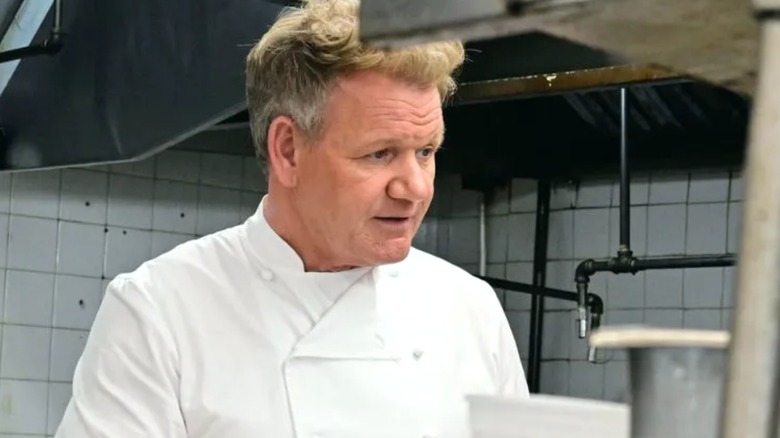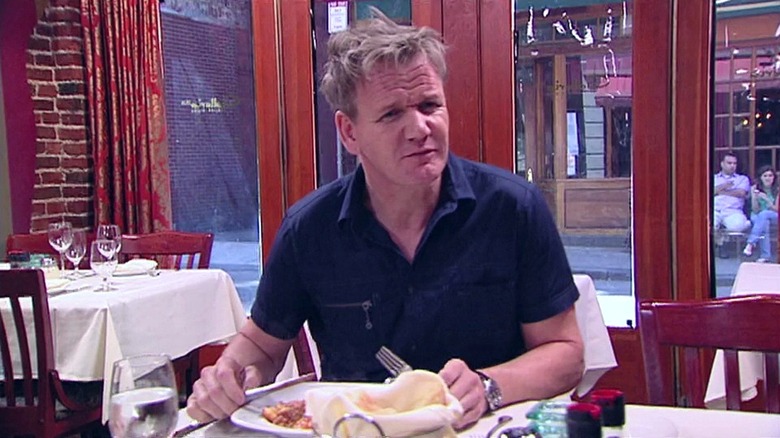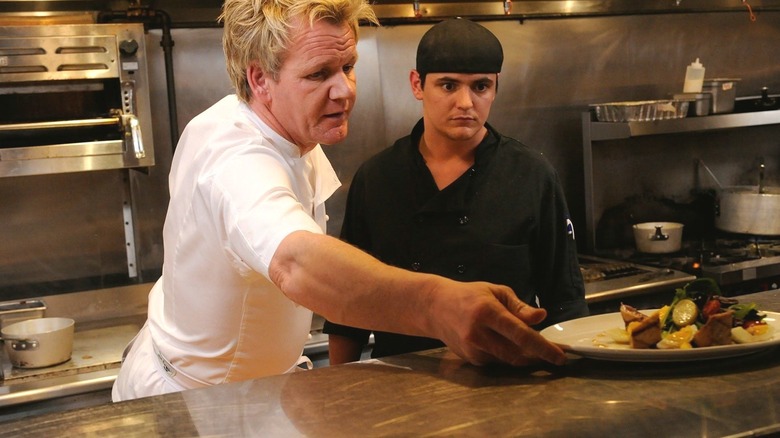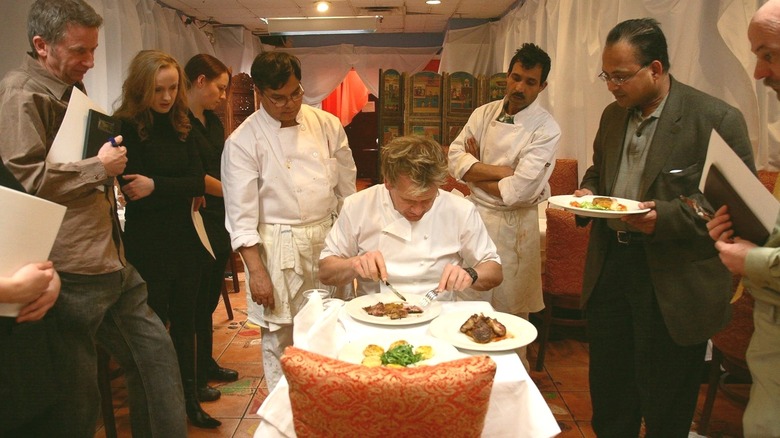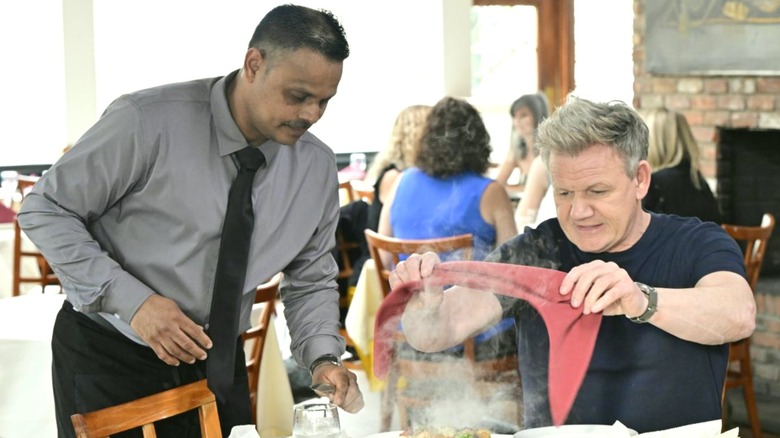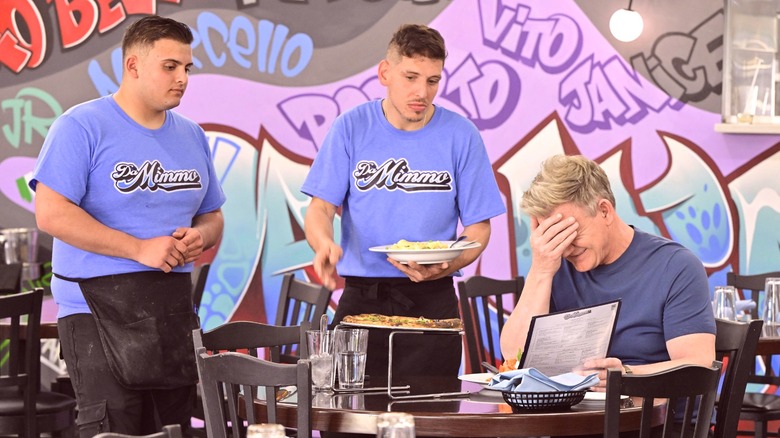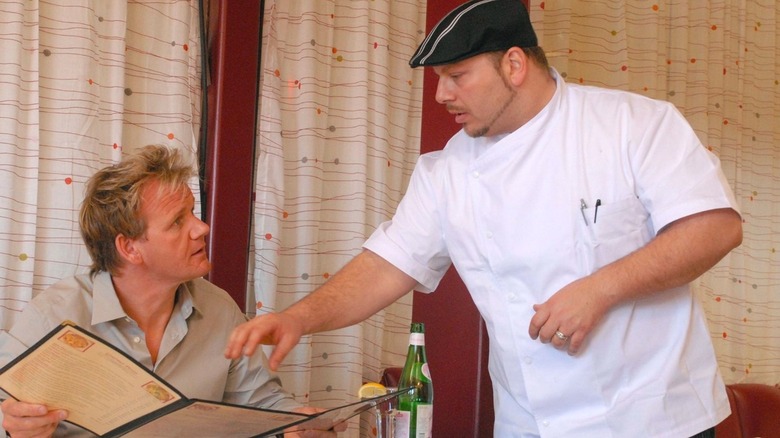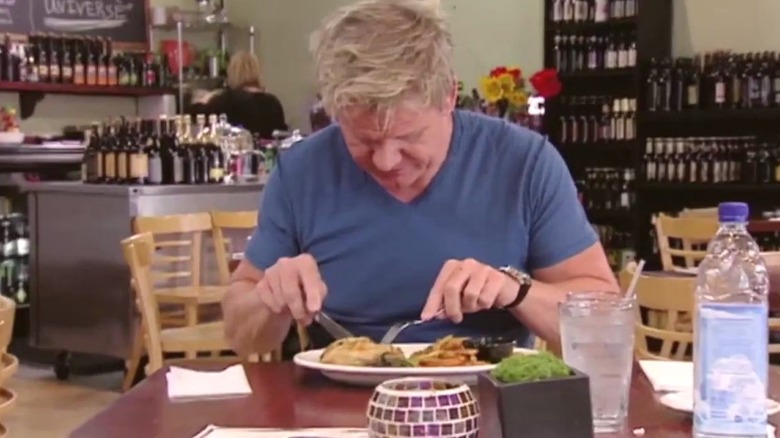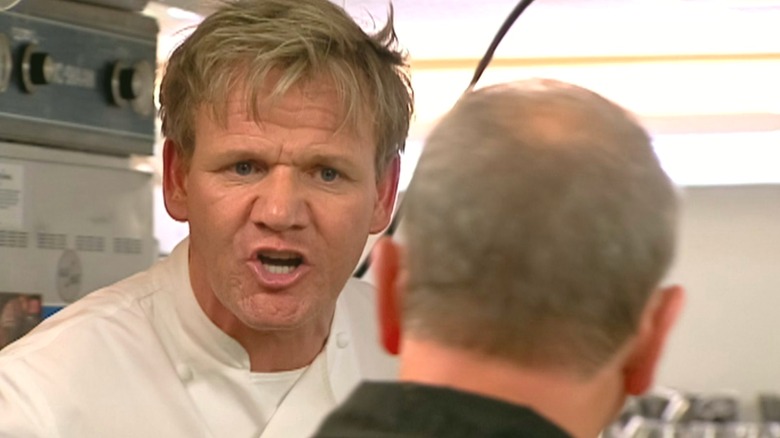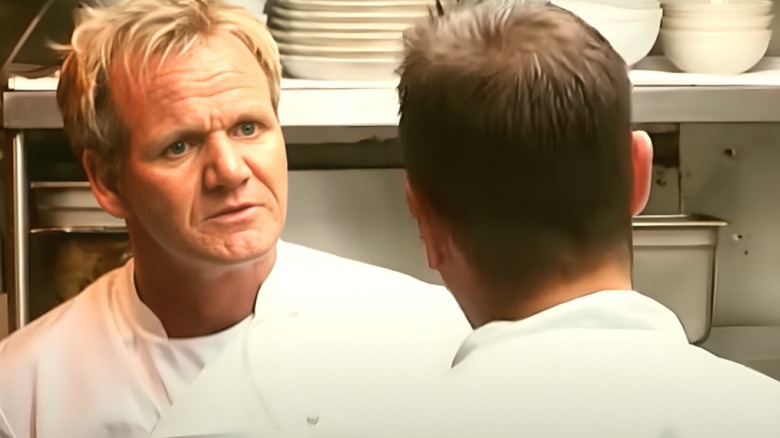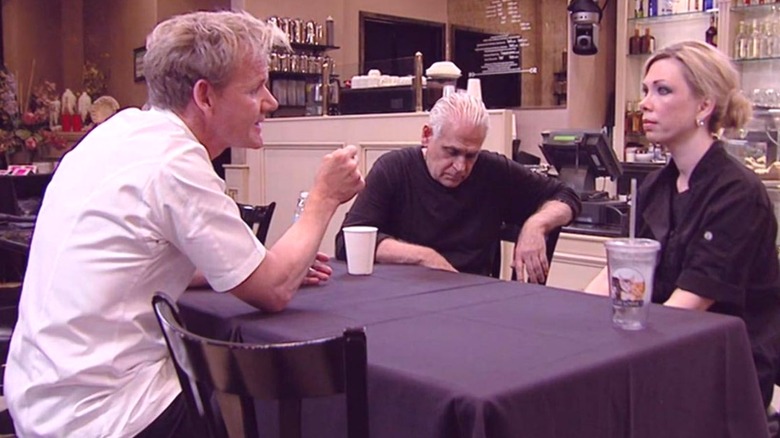10 Best Kitchen Nightmares Episodes Ranked
Long before he dominated the airwaves making chefs break down in tears on "Hell's Kitchen," Chef Gordon Ramsay was doing it in the U.K. His success across the pond afforded him the opportunity to bring concepts like "Hell's Kitchen" and "Ramsay's Kitchen Nightmares" to an American audience, and like the food he serves in his many restaurants, the Americans ate it up. Ramsay has grown to become a leading player in reality TV show cooking competitions entirely outside of the Food Network.
Ramsay is happy to put his future hires through hell to make them stars, and he's also not afraid to travel the country, tearing apart restaurant owners. Like "Hell's Kitchen," "Kitchen Nightmares" earned a U.S. adaptation, which produced 102 episodes by the end of 2024 and with the series' ninth season returning in January 2025. Many episodes of "Kitchen Nightmares" are excellent, as Ramsay guides American chefs toward prosperity, but not everyone listens to his advice.
Some of the best episodes of the series center around the most obtuse restaurant owners in existence, and not even a world-class chef can point them in the right direction. These are the episodes that make for great television — after all, it's often fun to watch someone crash and burn. While many restaurants do well after a visit from Chef Ramsay, not all of them do. These episodes are the best "Kitchen Nightmares" has to offer, and each one depicts a true kitchen nightmare Ramsay tries to fix.
La Galleria 33 - Season 6, Episodes 1 and 2
Chef Gordon Ramsey visits Boston's La Galleria 33 in the sixth season, and he was in for a challenge. The restaurant is owned by sisters Rita and Lisa, whose parents run a successful restaurant nearby. The daughters can't match their parent's success, however, so Ramsay goes to try and help. He immediately finds mistreated staff, easy-to-anger owners, an inept, self-appointed manager, and food that isn't fresh, which is a big no-no for Ramsay.
Throughout all of Ramsay's suggestions, menu ideas, and streamlining goals, the sisters fight and blame everyone but themselves for La Galleria 33's many problems. The final service has several hiccups, including the new POS system going down as things fall apart in the kitchen. Ultimately, the service is declared a success, despite some issues. The restaurant continued for a few years, but in the end, La Galleria 33 closed shop for good in November 2018.
Ramsay's visit to La Galleria 33 was told through the first two episodes of Season 6. The bickering sisters offered plenty of entertainment, warranting a two-part episode. Still, while watching, it's easy to land in one of two camps: Those who root for the sisters' failure, and those who hope to see them succeed in spite of all of their problems. These two episodes served as an excellent opener for Season 6, and they make for great reality television by showing just how bad some family members are at working together.
DownCity - Season 4, Episode 7
DownCity was a restaurant in Providence, Rhode Island, which is run by friends Rico and Abby. Rico works in finance and is the financial backer for the restaurant, while the day-to-day operations are handled by the more experienced Abby. Unfortunately, it turns out that Abby is a nightmare of a boss and is very difficult to work with — Chef Gordon Ramsay has his hands full dealing with her. Ramsay doesn't like DownCity's food, which upsets Abby, and their initial meeting is rather intense.
Ramsay quickly identifies Abby as the restaurant's primary problem, as she's in denial about the quality of the food, her abilities, and her attitude toward others. She and Ramsay have a tense exchange in the kitchen, where she blames him for mucking things up. Despite this, Ramsay continues to try and save DownCity from Abby's ineptitude and bad attitude. The final service goes well, and Abby admits that her bad attitude hasn't made DownCity successful.
When Ramsay leaves, it looks like things will improve for DownCity, but like many of the establishments visited by him, it would soon close. DownCity shut down in 2011, and it's easy to see why based on its Yelp reviews. One customer wrote, "Everything about this place was great AFTER Ramsay, and little by little, it degraded back into the dictatorship [it] always had been before." This episode is well worth watching simply to witness the train wreck that is Abby and how she is utterly dismissive of Ramsay's criticism.
Dillon's - Season 1, Episode 12
One of the most prevalent problems Chef Gordon Ramsay uncovers on "Kitchen Nightmares" is a disgusting kitchen. That's certainly what he stumbled upon at Dillon's, a restaurant just down the street from one of his own. Before making his way to the kitchen, Ramsay's first impression was that of a diverse menu, numerous managers working at the same time, and flies all over the place. The menu is possibly the most baffling, as it's a mixture of American, Irish, and Indian food.
He's served a rotten tomato, a vegetarian dish with meat in it, a beef dish that's actually lamb, and more. While the food and cleanliness of the restaurant and its kitchen are certainly a problem, Ramsay is more concerned about the abundance of incompetent managers. He finds that they don't intervene when necessary, and only one is good at their job. He consistently butts heads with Martin Hyde, the general manager, and the final service goes well despite Hyde's clumsy management.
At the end of service, Martin quits, and it looks like Dillon's (renamed Purnima by Ramsay) will succeed. While the renamed restaurant didn't last beyond 2009, that wasn't the end of the incredibly juicy story. Martin sued Ramsay for how he was portrayed on the show. The lawsuit sought £500,000 ($634,614), claiming Martin's reputation was destroyed by "Kitchen Nightmares," but his suit didn't go far before it was dismissed less than two months after it was filed in June 2006.
Diwan - Season 8, Episode 10
Diwan is an Indian restaurant in Port Washington, New York, but there's more going on in the kitchen than you might expect. The kitchen also supports a Mexican restaurant, so Diwan is essentially two locations in one, which causes some problems. Of course, the restaurant's biggest issue is its owner, Bobby Chhikara, who is incredibly stubborn and resistant to any of the changes Chef Gordon Ramsay recommends. Moreover, the Mexican mini-restaurant that's been chucked into the Indian motif is utterly unusual.
Ramsay typically suggests that the restaurants he visits have a simpler menu with fewer items, but Chhikara isn't eager to try this, as he expanded the menu to try to bring in more people. While it hasn't been working, he's reluctant to change the menu. It takes some work, but Ramsay finally gets Chhikara to allow for changes, and the restaurant adapts to Ramsay's suggestions. This leads to a remodel as well as a boisterous social media campaign to reinvigorate the public's trust in the longstanding eatery.
Things looked like they were working for Diwan when "Kitchen Nightmares" finished shooting, and it remains open as of late 2024. Unfortunately, it wasn't long before Chhikara reverted back to his old menu, abandoning the dishes Ramsay provided. It's always entertaining to see Ramsay butt heads with a stubborn restaurateur, which is why this episode is so fun to watch. Still, it's a shame to see a restaurant with decades of history fail to fully adapt to the changing times.
Da Mimmo - Season 8, Episode 4
There are many family-owned restaurants in the United States, but they don't all work out as well as the owners hope. That's certainly the case for Da Mimmo, an Italian restaurant in New Jersey run by a retired police officer and her three sons. After only six months of operation, Da Mimmo called Chef Gordon Ramsay because it was half a million dollars in debt as its profits plummeted. Ramsay immediately identifies several problems with Da Mimmo, including expired meats, rotten vegetables, and a one-hour wait for food.
One of the three sons, Antonio, is the only one who appears to be committed to making Da Mimmo work, while his brothers see the restaurant more as a joke. Antonio is both the pizza chef and manager, and he works hard to keep the place running. Ramsay implements numerous changes, including redoing the interior to make it more classy, replacing the cheap ingredients with fresh food of higher quality, and launching a streamlined menu and new work processes to make the kitchen run smoother.
Da Mimmo appeared to turn the business around by using Ramsay's menu, decorations, and other suggestions, and it remained open for a while. Unfortunately, Da Mimmo is now permanently closed, although the location may still be open for special events despite no longer operating as a restaurant. It's unclear why the restaurant is no longer open, but it's likely the owners weren't able to earn enough to settle their $500,000 debt and remain in operation.
Sebastian's - Season 1, Episode 6
There's no denying that Chef Gordon Ramsay is a stubborn person who prefers his way of doing things, but it's rare that he meets a restaurateur who matches him in this regard. That's what goes down when he heads to Sebastian's in Toluca Lake, California. Ramsay meets Sebastian Di Modica, the chef and owner who created his restaurant with a "concept" that confuses everyone except him. The wait staff and customers haven't a clue what Sebastian is doing, which is also why the restaurant is failing, necessitating some help from Ramsay.
It doesn't take Ramsay long to spot some serious issues centered around the food. He's served frozen calamari that's claimed to be fresh, and the pizza ovens aren't in use because the pizza isn't fresh or properly cooked. Ramsay decides an entirely new menu is the best option, as simpler makes for a more efficient kitchen. Sebastian sulks like a child and gets in Ramsay's face several times, even going so far as to reimplement his own menu during their final service, confusing everyone.
This episode makes for great television because of the overarching obstinance on display centered around Sebastian. He relents and goes back to work after sulking through most of the service, but it doesn't take. Sebastian abandoned Ramsay's menu after filming ended, and the restaurant closed in 2008, less than a year after Sebastian's was featured on "Kitchen Nightmares."
Burger Kitchen - Season 5, Episodes 5 and 6
Burger Kitchen is featured on two episodes of "Kitchen Nightmares," and they depict all the wrong ways to go about establishing and running a restaurant. The owner, Alan Saffron, claims to be a "meat sculptor," having opened Burger Kitchen due to his impressive knowledge of meats. It's quickly apparent that he doesn't know anything about his business, as he repeatedly mispronounces "Wagyu" and admits he only uses it for his burgers because it sounds expensive and fancy, proving he has no understanding of food quality.
Saffron is clearly delusional, and he's a hard man to like when the camera catches him treating his son terribly. Still, Chef Gordon Ramsay works to turn things around, but Saffron isn't willing to change or admit his mistakes. This leads Ramsay to subject the owner to a theater of Yelpers, each of whom negatively review the restaurant. Saffron's unwillingness to change his ways impacts the final service, as he constantly interrupts the kitchen.
Ultimately, the final service is a success despite Saffron's actions. Still, Ramsay doesn't leave before warning that a return to how things used to be would be a death sentence for Burger Kitchen. The episodes aired in November 2011, and the restaurant closed the following year, though it's unclear what finally pushed Saffron to make that decision. He died in April 2020 from a heart attack at age 71.
Mill Street Bistro - Season 6, Episodes 11 and 12
Chef Gordon Ramsay visits Mill Street Bistro in Norwalk, Ohio, in two episodes of "Kitchen Nightmare's" sixth season. The restaurant is owned and operated by Joe Nagy, who had absolutely no restaurant experience before diving in. Nagy has a sizeable ego; he abuses his staff (in front of customers) and is unwilling to admit to anything being his fault or responsibility. This, of course, makes him resistant to change — which is what he needs, or Mill Street Bistro will be out of business.
Ramsay and Nagy butt heads consistently throughout the episodes, making for entertaining television but a lot of frustration for Ramsay. He has to subject Nagy to hearing what his staff thinks are the reasons for the restaurant's lack of business, and they all point their fingers at him. He agrees to some changes, leading to a final service that goes better than most. Ramsay feels good about the staff and the changes he's implemented, but he worries Nagy will abandon it all in favor of his own methods.
Initially, Nagy keeps Ramsay's menu, and the restaurant has a chance of succeeding. This is dashed when Nagy returns to the kitchen despite promising to let his staff handle the cooking and back of the house. He renamed the restaurant, and less than two years after the episodes aired, it was no more. Nagy also sued Ramsay for damages to the restaurant, resulting in a settlement for £900 ($1,142).
Oceana - Season 4, Episode 14
They say the most important thing in real estate is location, and Oceana sure has a good one. The restaurant sits on New Orleans' famous Bourbon Street, which is home to many popular restaurants. Unfortunately, Oceana wasn't one of them, and the restaurant called in Chef Gordon Ramsay for help. Ramsay immediately notices several problems, including a dirty dining area and kitchen, staff who'd been repeatedly fired, and the owners, Moe and Rami Bader, complicating things.
Many members of the staff had been fired and rehired multiple times due to Moe's frightening temper. This influences everything in Oceana, from the food and staff to the customer experiences. Moe isn't happy about the changes Ramsay brings to the restaurant but admits to liking them after some prodding. With a new menu, new decor, and new attitude, Oceana knocks out a nearly perfect final service. Despite this, Ramsay isn't convinced that Moe understands what running a Bourbon Street restaurant is all about.
One of the biggest things to come out of this episode is the fact that Oceana's owners sued Fox to keep it from airing. While the episode did air, it's difficult to find because a settlement requires Fox to pay the Baders an unspecified fee whenever footage from the episode airs. A second lawsuit came years later due to a Facebook post regarding Oceana. Despite suing "Kitchen Nightmares" on two occasions, Oceana remains open as of late 2024, albeit operated by different owners.
Amy's Baking Company - Season 6, Episode 16
If you only ever watch one episode of "Kitchen Nightmares," make it the one detailing Amy's Baking Company in Scottsdale, Arizona. This episode features two owners, Sam and Amy Bouzaglo, who have no business operating a restaurant — or even interacting with people, for that matter. Unlike most places he visits, Chef Gordon Ramsay is impressed by Amy's Baking Company's cleanliness, organization, and decor. It doesn't take long for the Bouzaglos to make it clear that they are the problem.
During the episode, the owners berate, insult, and kick out any customer who complains, and there are many complaints about the food and service. The couple has hired and fired dozens of people. They are unwilling to listen to any of Ramsay's suggestions, nor are they willing to admit that the problems with their restaurant are in any way their fault. They call Yelp reviewers "liars" and "haters" and repeatedly attack them whenever they are criticized. Ultimately, the Bouzaglos refuse to continue with the show.
With their unwillingness to listen to anything he has to say, Ramsay leaves without finishing what he started. "Kitchen Nightmares" revisited Amy's Baking Company, and things devolved with the business closing and the couple divorcing, so it's fair to say "Kitchen Nightmares" didn't save this establishment. This episode is the only one to feature Ramsay giving up and leaving, adding to its intrigue. It's easily the best episode because, like any great reality TV show, it's best described as a train wreck happening in slow motion.
